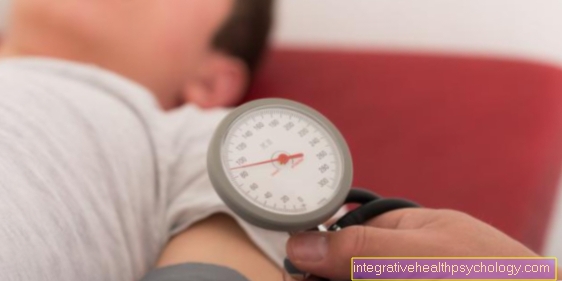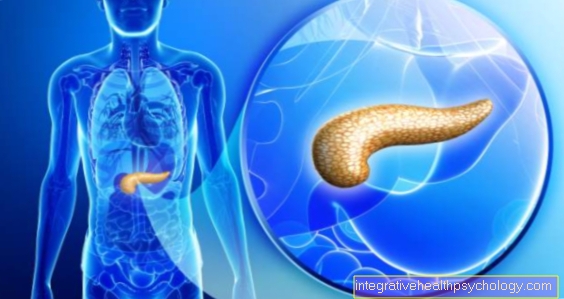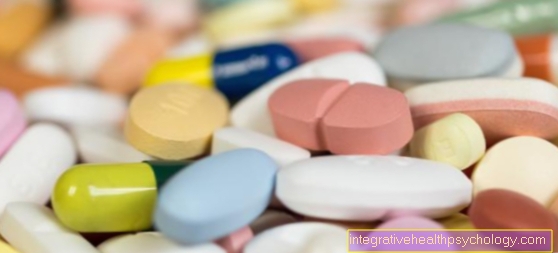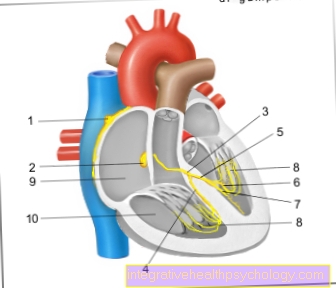potassium
This page deals with the interpretation of blood values that can be collected as part of a blood test.
function
Potassium is one of the vital electrolytes (salts). Many important metabolic processes are regulated by potassium.
Potassium and sodium form an opposing pair in our body. While sodium is essentially located outside the cells (in the so-called cell space), potassium is found in the cell. Therefore, for example, the level of potassium in a red blood cell (Erythrocyte) higher by a factor of 25 than in blood serum (blood fluid without cells).

The potassium content of our body is kept constant by various control mechanisms.
Potassium is absorbed through food in the small intestine, and that through the kidneys. The kidneys can excrete about 1 mmol / kg body weight in the urine in 24 hours.
In addition to potassium uptake, regulation is also subject to various hormones (for example glucocorticoids (insulin, glucagon) and mineralocorticoids such as cortisone), but also the acid-base status (proportion of acids and alkalis) in the body.
Determination methods
The potassium level is determined in the blood plasma or in the blood serum. A blood sample is necessary for this. Other Electrolytes in the blood to be determined.
Normal values of potassium
Potassium levels that are considered normal in an adult healthy person are in the range of 3.6 to 4.8 mmol / l.
more on the subject Potassium level at our partner.
Increase in blood value

An increase in serum or plasma potassium levels greater than 5.0 mmol / l is medically called Hyperkalemia designated.
Excessive potassium levels in the blood are most often indicated by symptoms Heart or on the nerves.
Common symptoms are sensory disturbances, numbness, but also muscle twitching. There are cardiac arrhythmias in the heart, which can also be detected by changes in the ECG.
Causes of hyperkalemia can be:
- incorrect blood collection
(If the upper arm is blocked for too long, there is a lack of oxygen, especially if the fist is opened and closed while the blood is being drawn, which means that the potassium from the cell is transferred to the blood plasma and the actual value is falsified)
(if the blood cells (White blood cells and red blood cells) is not separated from the blood plasma within an hour, there is a leakage of potassium from the cells, which also simulates a potassium level that is too high) - more pronounced Muscle injuries (Release of potassium from the cells)
- Tumor disease (Release of potassium from dying tumor cells)
- Renal failure / Kidney failure (due to insufficient potassium excretion)
- Medication (ACE inhibitors (blood pressure medicine) Antibiotics (for example Cotrim® = Drug at Cystitis (Cystitis)), NSAIDs (for example Ibuprofen), potassium-sparing diuretics such as spironolactone (Aldactone®), amiloride or triamterene
Low blood count
A decrease in plasma or serum potassium levels below 3.5 mmol / l is medically called Hypokalemia designated.
Usually cause potassium concentrations of less than 2.5 mmol / l Symptoms. Symptoms are particularly common when the potassium level falls particularly quickly.
With potassium levels below 3.0 mmol / l imagine a Cardiac arrhythmia a.
With a slow decrease, the body can adapt to the new potassium values.
Causes of hypokalaemia can be:
- diarrhea (Loss of potassium via the Intestines)
- Vomit
- Taking laxatives (loss of potassium from the intestines)
- Diabetes mellitus (diabetes), as part of the disease, it can lead to a metabolic imbalance (Ketoacidosis). To restore the acid-base balance, the kidney increased potassium.
- stress (Stress leads to the release of adrenaline. Adrenaline causes the cells to absorb potassium)
- Medications such as antibiotics (for example penicillin)
- leukemia (the increased white blood cells (Leukocytes) absorb potassium)
Foods rich in potassium
Foods with potassium are primarily plant-based foods:
- Grain, vegetables (Potatoes, lettuce, parsley, spinach ...)
- fruit (Bananas, apricots, figs, honeydew melons, kiwis, berries, peaches, grapes ...)
- nuts
Meat and fish also contain potassium, but not to the same extent as the plant foods mentioned above.
Note:
If the vegetables are boiled or stored in water for a longer period, the potassium escapes into the water and is lost. This effect can be used when the potassium level is increased.
Potassium deficiency
introduction

In the adult, lies a Potassium deficiency before when the Potassium concentration in the blood serum below 3.5 mmol / l lies. The doctor then speaks of a "Hypokalemia". But how does a potassium deficiency come about?
root cause
Normally, our bodies can get sufficient amounts of this important mineral from food. However, various causes lead to an increased loss of potassium in our body. Both over the Gastrointestinal tract, as well as the kidney In principle, dangerous potassium losses are possible. The most common cause are chronic vomiting, chronic diarrhea such as the misuse of laxatives. Through the kidneys, a potassium deficiency can e.g. through certain "Water tablets“ (Diuretics) caused. But also insulinas given to diabetics, can promote mineral loss.
Symptoms
If the deficiency is more pronounced, can Cardiac arrhythmias, such as. ventricular or supraventricular extrasystoles observe. Here the heart beats "out of line", so to speak - often uncomfortably noticeable for those affected. It also causes potassium deficiency constipation. In the longer term, our kidneys' ability to concentrate urine is diminished. If the potassium deficiency persists, permanent Kidney damage be the consequence.
Diagnosis
Primarily, the doctor diagnoses a potassium deficiency with a Blood test. To determine possible effects on the heart, a EKG to be written. In order to find the cause, a detailed survey (anamnese) required.
therapy
Priority should always be given to the cause of the potassium deficiency. Often is one additional gift of the mineral necessary to achieve rapid symptom improvement. In many cases, suffice Effervescent potassium tablets, Fruit juices and Bananas to normalize potassium levels. 100 g of banana contains around 358 mg of potassium! Because of the possible risk of cardiac arrhythmias if the increase is too rapid, the decision to give intravenous potassium is rather cautious.
Also read more on the topic : Potassium deficiency





























